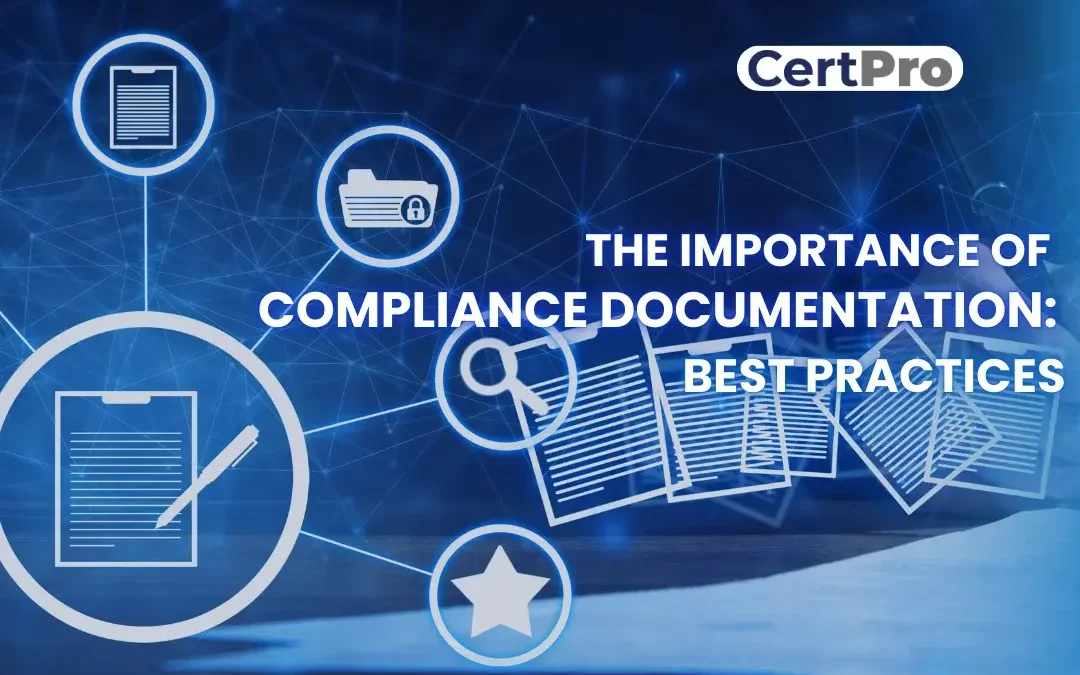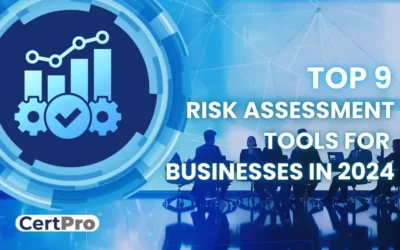Compliance documentation is like a manuscript that shows your company meets the rules set by regulators. Businesses constantly change policies and regulations, making documentation harder to understand. The documentation must include old and new policies, clear step-by-step guidelines, and evidence. Thus, the whole process shows that the company is committed to following the rules and standards specific to its business. Also, well-defined compliance documentation is essential for modern companies to keep data safe and reduce threats.
In this blog, you will learn about the compliance documents in detail, along with the importance and challenges of the process. Read the blog to enrich your knowledge and satisfy your queries.
WHAT IS THE COMPLIANCE DOCUMENTATION PROCESS?
Compliance documentation is keeping specific records of your organization’s compliance practices. It shows that the compliance plan has been followed. Organizations can also use the documentation process during audits and certification of compliance.
It means keeping certain records to check that compliance is being followed. For compliance documentation example, let’s say that your compliance method requires security training for all employees once a year. Thus, the compliance documentation must include the steps and proof that your employees are getting the right training according to the rules. In the same way, the document has details about the strategies, SOPs, and audit reports that help with the compliance process.
WHAT IS THE IMPORTANCE OF DOCUMENTATION?
Businesses stay compliant with specific regulations through the documentation process. On the other hand, maintaining documentation can bring everyone on the same page regarding compliance practice. Let’s discuss the importance of documentation in brief:
Provide Visibility: It gives you a full picture of and easy access to your company’s rules and laws. Not only that, but the documentation method can also find vulnerabilities and rank risks based on impact. Because of this, documentation helps your company understand risks and decide how to reduce them.
Streamlines Business Operations: Documentation eliminates the risk of downtime in your organization. Consequently, it helps employees understand their respective roles in dealing with security incidents. Thus, the business operation process remains functional during the emergency.
Simplifies Compliance Process: Compliance documentation ensures that your organization’s employees know compliance policies. Hence, proper training can improve their knowledge and skills in handling sensitive data. It also adds security layers to your organization and elevates the overall security posture. Therefore, documentation helps comply with regulations and eliminates non-compliance risks.
Cost-Effective: Compliance management tools help with the compliance documentation process and aid in auditing. Investing in compliance management tools can be an excellent way to escape fines and penalties for not following the rules. On the other hand, the documentation method makes it easier to keep up with compliance and helps in surveillance audits.
Enhanced Collaboration: The process fosters collaboration between an organization’s different departments. How does it help in collaboration? Documentation requires collaboration and collective efforts. Thus, it helps maintain uniform workflows within organizations. In addition, the process enables continuous improvement for better business outcomes.

WHAT ARE THE BEST PRACTICES IN DOCUMENTATION?
Documentation follows specific guidelines as per the compliance framework. For example, a healthcare facility follows HIPAA rules for protecting patient information. It must collect all of its patient information security processes and procedures. Suppose a company has more than one compliance framework; it needs to keep track of all the controls it has put in place and the proof it has to show that it meets each compliance rule. However, some best practices are enlisted for better understanding:
Documentation of Policies and Procedures: Compliance with data privacy and other regulatory laws requires organizations to follow specific rules. Hence, organizations must document and record the necessary policies and procedures. Clear guidelines and processes must be included in compliance documentation to help define the scope of audits and make operations run more smoothly.
Evidence of Recovery and Remediation Plans: Documentation must include remediation activities during security incidents. This helps the auditor recognize organizations’ action plans during crises. In addition, the stakeholders should approve the mitigation strategy, as it signifies their consent. Changes in the compliance program need to be incorporated into the documentation.
Enlist Data Protection Policies: Compliance documentation details specific policies and processes organizations follow to protect the client’s data. Customers have the right to access and know about their data. Customers are sometimes asked for details of organizations’ processes to safeguard their data. In this regard, documentation can help organizations to justify their demands with proof.
Documentation of Staff Training: The documentation must incorporate periodic employee training and awareness evidence. This helps maintain compliance and eliminate the risk of unethical practices or human error in the organizations.
Regular Updates of Documentation: Documentation helps organizations identify issues periodically. Thus, record-keeping helps analyze issues and investigate their causes to eliminate the risk of re-occurrence. Furthermore, it assists in creating incident reports and future strategies. Most importantly, outdated documentation is a severe concern for many organizations. If you fail to review or update the documentation process, it creates gaps in the compliance practice. Thus, review your organization’s documentation process to find out the vulnerabilities.
HOW TO IMPROVE THE COMPLIANCE DOCUMENTATION PROCESSES?
Compliance documentation requires constant monitoring and reviewing to update the records and find discrepancies. Here are some processes that can improve the documentation process:
Digitize the Documentation Process: Digitalization of compliance documentation is prevalent in today’s environment, where remote working is expected. In this process, documents are stored in the cloud and accessible to all authorized users. Therefore, finding the correct documents becomes super simple with digitization. Another advantage of digitization is that it replaces old documents with new ones without error. Multiple tools are available to organize, store, and monitor documentation.
Reduce the Security Concerns: The manual compliance documentation process has multiple security concerns. First, it is difficult to restrict the specific file from unauthorized access. Second, the manual process has a considerable risk of damage or accidental destruction. However, with the digitization process, you can restrict access to specific documentation, and it reduces the risk of human error. Similarly, digitization requires staff training to manage and handle digital documentation.
Periodic Reviews and Audits: Regular reviews and audits are required to ensure that the documentation is up-to-date and comprehensive. The process helps recognize the business’s need to comply with current documentation standards. In addition, reviewing the compliance process incorporates the stakeholders in improving an organization’s future path.
Staff Training: Employees play a crucial role in the compliance implementation process. Therefore, staff training improves expectations and understanding of compliance ecosystems. It reduces the work burden and streamlines the overall process. Documentation helps employees understand the policies and processes. It clarifies the course of action in the compliance process.
Automating the Processes: Automating processes reduces the manual work related to compliance processes. Therefore, the software helps record information and make the documentation process simpler and more efficient. In addition, automation can restrict the unauthorized access or manipulation of records. Thus, the risk of error is reduced in the documentation process.
WHAT ARE THE CHALLENGES OF COMPLIANCE DOCUMENTATION?
Managing documentation is a complex process requiring the detailing of each control. Some common challenges are:
Time-Consuming Process: Documentation can take a lot of time when performed manually. The manual process includes entering the same information repeatedly, keeping track of many spreadsheets, and making mistakes, which is a natural part of human work. Small—to medium-sized businesses have trouble with documentation because of a lack of resources. So, keeping an eye on the integrity of documents can be challenging, especially when practiced manually.
Staying Up to Date: The changing regulatory landscape increases difficulties in staying up to date with the latest regulatory practices. Some common challenges include difficulties maintaining documents and regularly updating policies and practices. Therefore, comprehensive record-keeping is necessary to fulfill the compliance requirements. However, gathering and storing this evidence manually can be challenging.
Compliance Training: Ensure employees get the proper training on the documentation process. Practical training speeds up the implementation process, and adequate training eradicates errors.
FINAL THOUGHTS
The first thing you must do to be compliant is ensure you have a proper documentation process. This offers a more robust view of information security, which helps businesses stay safe from online dangers. On the other hand, manual documentation is more difficult to manage for large organizations. Thus, you can automate the documentation process to streamline the process. Also, the documentation needs to match the compliance goals so the compliance process can go smoothly.
Furthermore, automation of documentation makes maintaining the documentation and evidence hassle-free. Well-maintained documentation acts as a single source of truth for compliance-related documentation. It helps you gain control over the organization’s internal policies and compliance strategies.
FAQ
How often should compliance documents be reviewed and updated?
It requires review at least annually. In addition, we need to update the records whenever changes occur in the compliance process.
How do technological advancements impact compliance documentation?
Technological advancement streamlines the accessibility, security, documentation, and compliance monitoring process.
What is the SOC 2 standard documentation?
It is the tangible proof of your implemented policies, procedures, and other internal controls about the five Trust Services Criteria.
What is InsiderLog?
It is software that helps you fulfill your obligations to record inside information and notify insiders of their commitments.
What is an example of a document of compliance?
Full Material Disclosures (FMD), Certificates of Compliance (CoC), and Statements of Compliance (SoC) are examples of compliance documents.

About the Author
BENEDICT ESSANDOH
Benedict Essandoh, CertPro’s Regional Director in Ghana, is a compliance and ISO standards expert. Specializing in health and safety, he conducts audits, implements ISO 9001 and ISO 45001, and excels in accident investigation and site inspections, ensuring international standards are met.
INFOSEC RISK MANAGEMENT IN 2024: EFFECTIVE TIPS FOR SIMPLIFICATION AND MITIGATION
In today's businesses, the value of information is no less than any asset a company possesses. However, consecutive cyberattacks and threats disturb the collecting and storing process of information. Thus, the incident of emerging cyber threats enhances the risk to...
TOP 9 RISK ASSESSMENT TOOLS FOR BUSINESSES IN 2024
Risk assessment helps organizations strengthen their security posture and recognize potential risks to their compliance processes. It also evaluates the severity of the risk and minimizes its impact on business operations. In addition, risk assessment tools are...
COMPLIANCE RISK MANAGEMENT: EXPERT STRATEGIES AND BEST PRACTICES
Compliance risk considers the organization's potential legal, material, and financial losses due to compliance failure. Thus, compliance risk is known as integrity risk. Organizations of all sizes are exposed to compliance risk. Hence, compliance failure results in...




